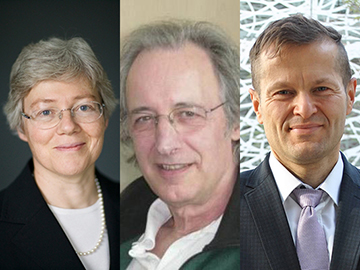History

Anne L’Huillier, Pierre Agostini, and Ferenc Krausz
Electrons moves at a nearly incomprehensible pace, in the scale of attoseconds—one billionth of a billionth of a second. Peering into the world of electrons requires pulses of light at the same hyper-fast scale. Optica Fellows Pierre Agostini, Frenec Krausz and Anne L’Huillier have each contributed to developing ways to create attosecond pulses of light, providing a new view into the behavior of electrons.
All three laureates are long-time Optica members, Fellows and volunteers. They demonstrate a dedication to the science of light and to the community of practitioners who benefit from their insights. As was noted, Prof. L'Huillier was called while she was teaching and after being told of the award, returned to her lecture. See Prof. L'Huillier give a Plenary lecture at the 2021 Frontiers in Optics meeting.
Drs. Agostini, Krausz and L’Huillier have pushed the limits of what’s possible through light. Agostini, Krausz and L’Huillier have each made remarkable contributions to our ability to harness super-fast pulses of light, giving us the power to study and manipulate electrons. This is potentially world-changing technology, and we congratulate these Optica Fellows for their well-deserved recognition.
Pierre Agostini is an Emeritus Professor at the Ohio State University, where he leads a research group that continues to delve into ultra-fast atomic physics. He earned his doctoral degree from Université Aix-Marseille in 1968, then becoming a researcher at CEA Saclay, the French Atomic Energies and Atomic Energy Commission. It was there in 2001 that he created a “pulse train” technique, building on previous work from L’Huillier, resulting in a series of consecutive laser pulses of 250 attoseconds. He has received the Joop Los Award from FOM Netherlands, Optica’s William F. Meggers Award in 2007 and is a Humboldt Fellow. He was elected a Fellow of Optica in 2008.
Ferenc Krausz is Director of the Max Planck Institute of Quantum Optics and Professor of Experimental Physics at Ludwig Maximilian University of Munich. He received his doctorate in 1991 from Vienna University of Technology, where he would later become a Professor of Electrical Engineering. In 2001, the same year Agostini conducted his light pulse experiments, Krausz and his team became the first to produce and isolate a single light pulse, lasting 650 attoseconds. He has received numerous awards, including the 2022 Wolf Prize alongside L’Huillier, and was elected a Fellow of Optica in 2009.
Anne L’Huillier is a professor of atomic physics at Lund University in Sweden. In 1987, she became one of first researchers to see the potential to use the extreme ultraviolet pulses that are generated through high harmonic generation to produce even shorter pulses at the attosecond scale. She is a Fellow of Optica and APS, and has received many awards for her work in ultra-fast physics, including Optica’s 2021 Max Born Award, the 2022 Wolf Prize, and the 2023 Leibinger Award.
Optica applauds the recognition of Pierre Agostini, Ferenc Krausz and Anne L’Huillier for their work in ultrafast physics and the high-harmonic generation of light by 2023 Nobel Physics committee. The work of these three scientists has opened a window into the dynamics of chemical reactions, the motions of electrons, and the unique tones of molecular vibrations. This is possible through the power of light.
Select Relevant Papers Available from Optica Publishing Group
The three Nobel Laureates have published papers with Optica Publishing Group. A selection of their papers related to their work recognized by the Nobel Prize is included below.
-
High-power few-cycle Cr:ZnSe mid-infrared source for attosecond soft x-ray physics
Leshchenko, Vyacheslav E.; Talbert, Bradford K.; Lai, Yu Hang; Li, Sha; Tang, Yaguo; Hageman, Stephen J.; Smith, Greg; Agostini, Pierre; DiMauro, Louis F.; Blaga, Cosmin. Optica 7(8) 981-988 (2020).
-
Leshchenko, Vyacheslav; Li, Sha; Agostini, Pierre; DiMauro, Louis F. Optics Letters 48(19) 4949-4952 (2023)
-
Herrmann, Daniel; Veisz, Laszlo; Tautz, Raphael; Tavella, Franz; Schmid, Karl; Pervak, Vladimir; Krausz, Ferenc. Optics Letters 34(16) 2459-246 (2009).
-
Two phase-matching regimes in high-order harmonic generation
Appi, E.; Weissenbilder, R.; Nagyillés, B.; Diveki, Z.; Peschel, J.; Farkas, B.; Plach, M.; Vismarra, F.; Poulain, V.; Weber, N.; Arnold, C. L.; Varjú, K.; Kahaly, S.; Eng-Johnsson, P.; L’Huillier, A. Optics Express 31(20) 31687-31697 (2023).
-
High-speed carrier-envelope phase drift detection of amplified laser pulses
Fordell, T.; Miranda, M.; Arnold, C. L.; L’Huillier, A. Optics Express 19(24) 23652-23657 (2011).
